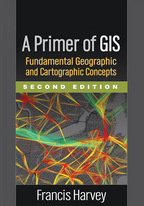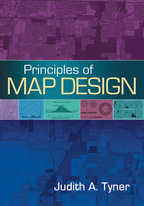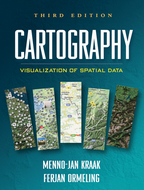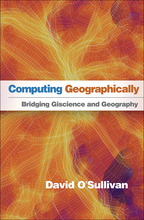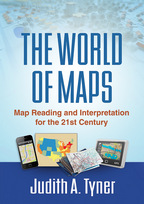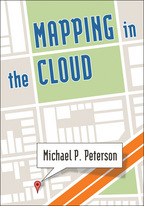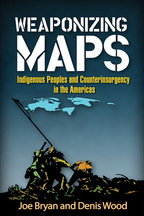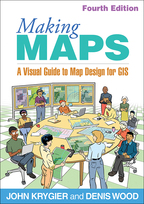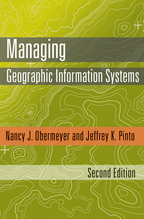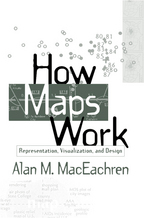A Primer of GIS
Second Edition
Fundamental Geographic and Cartographic Concepts
Francis Harvey
HardcoverPaperbacke-bookprint + e-book
Hardcover
orderOctober 28, 2015
ISBN 9781462522187
Price: $117.00 360 Pages
Size: 7" x 10"
Paperback
orderOctober 29, 2015
ISBN 9781462522170
Price: $78.00360 Pages
Size: 7" x 10"
“Harvey…packs a tremendous amount of information into a single volume. It is arranged with a textbook presentation, including discussion questions and exercises. This could have become a simple taxonomy, but Harvey presents the key issues in clear language. Mapping sciences have evolved rapidly in recent years; this book reflects the transition from cartography to geographic information use….This is an excellent option for instructors building an introductory lecture/lab course who need a primary text….Recommended. Lower-division undergraduates.”

—Choice Reviews
“An important contribution....Provides the beginner as well as the more advanced GIS user with the knowledge to bridge the gap between the conceptual and the practical in GIS....The concepts, principles, issues, and applications covered in the book are important to all aspects of GIS-related planning issues in all parts of the world, and most students, teachers, and practitioners will gain valuable insight from this book, particularly those without a background in GIS or geography.”

—International Planning Studies (on the first edition)
“Harvey provides a unique resource that blends presentation of geographic information concepts, cartography principles, and GIS technology application. The well-developed linkages between geographic information and cartography are particularly valuable. All levels of readers will rediscover the importance of appropriate mapping technique in GIS practice, whether in the desktop, Web, or mobile environment. The second edition has been thoroughly updated and includes new material on Web applications and Big Data issues. While the contents are organized to provide a comprehensive overview of GIS, individual sections and chapters can also be flexibly used as stand-alone modules.”

—Jeff Hamerlinck, PhD, Director, Wyoming Geographic Information Science Center, University of Wyoming
“A well-written text that introduces the fundamentals of spatial geographic information. The coverage is broad and up to date, and the concepts are well explained. I like the pedagogical features—the end-of-chapter review questions with answers will help students understand the concepts and methods discussed in lectures, and the end-of-chapter exercises and extended exercises will further strengthen students’ understanding of course materials.”

—Jun Liang, PhD, Department of Geography, University of North Carolina at Chapel Hill
“The writing style is authoritative yet genial, and doesn't overwhelm the reader, as other texts on this topic may do. For example, the author invites the reader to look out the window and then view a map of the same area, a simple exercise that makes the experience of reading personal, immediate, and interactive. The discussion of map projections and geoid, ellipsoid, and spheroid models is robust; this is an underlying concept of GIS, and one of the most difficult for students to comprehend, so it is important to give it such focused attention.”

—Karen E. Blevins, MA, Geography Program, Mesa Community College
“An invaluable resource for a broad range of students and instructors. The text puts human communication about the environment before GIS commands and file formats. The engaging, conversational style provides easy access to rich insights on how maps and geographic information are used to answer important questions. The text covers a wide range of issues pertaining to mapping in the digital age, from measurement to decision making. It will make the reader curious to dig deeper into the many human, technical, and organizational aspects discussed. Harvey's emphasis on choices to make in communicating about the environment fosters dearly needed critical thinking about geographic representations and computations.”

—Werner Kuhn, PhD, Jack and Laura Dangermond Chair, Department of Geography, University of California, Santa Barbara
“A great introduction to cartographic analysis and GIS. Harvey covers a broad range of information that will appeal to many students and professionals with different specializations in geography. The text encourages the reader to think critically about the implications of using GIS and the future of the field. The material is up to date and includes helpful hands-on examples and exercises. I was happy to see the new chapter on online mapping, which covers very current topics, such as Big Data. I also like the detailed description of geocoding and the revamped discussion of privacy and surveillance. This is an enjoyable text to read, and one that I will definitely recommend.”

—Holly M. Widen, PhD candidate, Department of Geography, Florida State University
“This solid introductory text presents fundamental concepts in an easy and accessible manner that brings complicated content to life. The sequencing of the book makes it possible for instructors to switch the chapters around. It provides an essential framework that allows me the flexibility to fill in additional details that I want my students to have on a particular topic. At the same time, I feel confident that students who read only this book would have a solid understanding of the central concepts of GIS.”

—Timothy LeDoux, PhD, Department of Geography and Regional Planning, Westfield State University
“A substantive introduction to our rapidly expanding field. The second edition includes a new overview of GIS that is chock full of teachable applications from across the industry; new and updated figures; and a section focused on Web GIS, big data, and online mapping. Harvey conducts a broad-brush tour across the constellation of geotechnologies that have been swept into the realm of GIS, such as global navigation satellite systems and remote sensing. This text will serve well for students and professionals who are starting out fresh or entering the field from another discipline.”

—Patrick McHaffie, PhD, Department of Geography, DePaul University
—Choice Reviews
“An important contribution....Provides the beginner as well as the more advanced GIS user with the knowledge to bridge the gap between the conceptual and the practical in GIS....The concepts, principles, issues, and applications covered in the book are important to all aspects of GIS-related planning issues in all parts of the world, and most students, teachers, and practitioners will gain valuable insight from this book, particularly those without a background in GIS or geography.”
—International Planning Studies (on the first edition)
“Harvey provides a unique resource that blends presentation of geographic information concepts, cartography principles, and GIS technology application. The well-developed linkages between geographic information and cartography are particularly valuable. All levels of readers will rediscover the importance of appropriate mapping technique in GIS practice, whether in the desktop, Web, or mobile environment. The second edition has been thoroughly updated and includes new material on Web applications and Big Data issues. While the contents are organized to provide a comprehensive overview of GIS, individual sections and chapters can also be flexibly used as stand-alone modules.”
—Jeff Hamerlinck, PhD, Director, Wyoming Geographic Information Science Center, University of Wyoming
“A well-written text that introduces the fundamentals of spatial geographic information. The coverage is broad and up to date, and the concepts are well explained. I like the pedagogical features—the end-of-chapter review questions with answers will help students understand the concepts and methods discussed in lectures, and the end-of-chapter exercises and extended exercises will further strengthen students’ understanding of course materials.”
—Jun Liang, PhD, Department of Geography, University of North Carolina at Chapel Hill
“The writing style is authoritative yet genial, and doesn't overwhelm the reader, as other texts on this topic may do. For example, the author invites the reader to look out the window and then view a map of the same area, a simple exercise that makes the experience of reading personal, immediate, and interactive. The discussion of map projections and geoid, ellipsoid, and spheroid models is robust; this is an underlying concept of GIS, and one of the most difficult for students to comprehend, so it is important to give it such focused attention.”
—Karen E. Blevins, MA, Geography Program, Mesa Community College
“An invaluable resource for a broad range of students and instructors. The text puts human communication about the environment before GIS commands and file formats. The engaging, conversational style provides easy access to rich insights on how maps and geographic information are used to answer important questions. The text covers a wide range of issues pertaining to mapping in the digital age, from measurement to decision making. It will make the reader curious to dig deeper into the many human, technical, and organizational aspects discussed. Harvey's emphasis on choices to make in communicating about the environment fosters dearly needed critical thinking about geographic representations and computations.”
—Werner Kuhn, PhD, Jack and Laura Dangermond Chair, Department of Geography, University of California, Santa Barbara
“A great introduction to cartographic analysis and GIS. Harvey covers a broad range of information that will appeal to many students and professionals with different specializations in geography. The text encourages the reader to think critically about the implications of using GIS and the future of the field. The material is up to date and includes helpful hands-on examples and exercises. I was happy to see the new chapter on online mapping, which covers very current topics, such as Big Data. I also like the detailed description of geocoding and the revamped discussion of privacy and surveillance. This is an enjoyable text to read, and one that I will definitely recommend.”
—Holly M. Widen, PhD candidate, Department of Geography, Florida State University
“This solid introductory text presents fundamental concepts in an easy and accessible manner that brings complicated content to life. The sequencing of the book makes it possible for instructors to switch the chapters around. It provides an essential framework that allows me the flexibility to fill in additional details that I want my students to have on a particular topic. At the same time, I feel confident that students who read only this book would have a solid understanding of the central concepts of GIS.”
—Timothy LeDoux, PhD, Department of Geography and Regional Planning, Westfield State University
“A substantive introduction to our rapidly expanding field. The second edition includes a new overview of GIS that is chock full of teachable applications from across the industry; new and updated figures; and a section focused on Web GIS, big data, and online mapping. Harvey conducts a broad-brush tour across the constellation of geotechnologies that have been swept into the realm of GIS, such as global navigation satellite systems and remote sensing. This text will serve well for students and professionals who are starting out fresh or entering the field from another discipline.”
—Patrick McHaffie, PhD, Department of Geography, DePaul University

